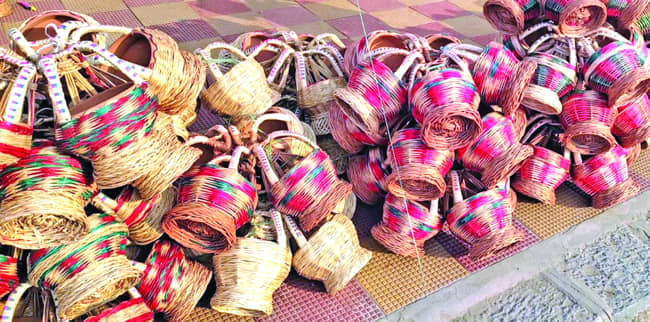Traditional Kashmiri Kangri is back as temperature touched sub zero
Artisans are busy to meet demand of local market

MASROOR AHMAD
BUDGAM: In addition to modern-day heating appliances, such as electric blankets, gas heaters and electric Hammam and traditional Hammams as well as woolens are available to cope with the chilling cold but one thing that Kashmiris think of while making preparations for winter is Kangri, an earthen pot encased in an exquisitely woven wicker basket.
Kashmir experiences harsh winters from November to the ending February every year, with temperatures dropping to -8 degree Celsius, but Kashmiris have traditionally used Kangri and Pheranto fight the cold.
The Kashmir valley is witnessing an increase in demand for a traditional fire pot known as ‘Kangri’ these days as the winter ice grip strengthens. Artisans in the villages of various districts including Budgam are working tirelessly to produce thousands of Kangri’s every day to meet this seasonal surge.
The craft of making Kangris is a community affair. It is woven in four distinct styles, for different occasion like, Khoja Kanger for elite class or rich people used in functions, Mahren Kangir, or bridegroom Kangri which is being gifted to newly wedded couples. Each type has its own set of admirers and price points, catering to a diverse customer base.
Artisan families that make the Kangris are spread in different villages across Kashmir .The potter makes an earthen bowl. The Kangri-maker weaves the wicker basket around the bowl, providing two handles so that it can be carried easily ,besides a base is made to balance the kangri on the floor.
According to artisans, Charar Kangri made in Charari e Sharief area of Budgam district takes the highest preference among customers. It’s is Charar Kangir that has truly captured the hearts of the local people, it is being made in a charming way for history and culture.
“We produce daily 500 to 1000 Kangris every day in the area. Our Kangris reach every nook and corner of Kashmir, from North to South, as people throughout the Kashmir valley find ‘Chara rKangiri’ as the best winter remedy. Making a Kangri needs a lot of skill and patience. Men and women collect the slender wicker twigs from forests. They process the twigs by scraping, peeling, boiling, and drying before weaving them into Kangris. As each process requires skilled hand, thousands earn their living in the production of Kangris,” artisan said.
From the beginning of November, one can see the delectable presence of Kangris stacked up for sale in every market across Kashmir.
Depending on the design, each Kangri has different price between 150 to Rs 2000, but for common use sold at an affordable price range of Rs 150 to Rs 250 and the sale lasts until early spring .
”With the Kashmir Valley witnessing long power cuts in winter, many find it practical to use Kangris to warm their homes. We have electric heaters but due to power shortage we are not able to use these electric gadgets so we are dependable on traditional Kangri”, said Shanawaz a young man from Budgam.
Some citizens said that even if there is a regular power supply, Kangri would still not lose its significance given its economic viability as compared to electric and gas heaters. Using Kangri for heating doesn’t cost much and it has been seen that Kashmiri people can live without electricity but not without Kangri, as we are finding extremely useful. Whoever invented it must have been a genius .
Despite the thriving local business, artisans voiced concerns over the lack of government support, emphasising the challenges they face when seeking financial aid to expand the trade.
“Banks require a government employee as a guarantor for loans, and even then, the interest rates are high,” he explained, asserting the need for government assistance to elevate the Kangri industry.
